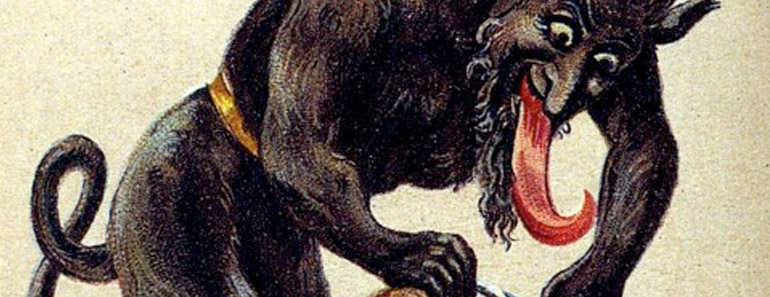
If you’re looking for some schlocky horror shocks as Christmas approaches, you might want to check out Krampus, a new film starring Toni Collette and an enormous evil goat man. That’s Krampus, and he hasn’t been dreamed up in some coke-fuelled writers’ room, no Krampus has a long history in the Alpine regions of Germany and Austria.
Santa Claus is a giving kind of Christmas guy. We may pretend he checks his list to see who’s been naughty of nice before handing out his gifts, but beyond the possible withholding of games consoles from the undeserving young, Santa has no teeth.
But it wasn’t always this way. Santa was born from the old European legend of St Nicholas, a third-century Turkish bishop who once got so angry with an early dissenting believer that he gave him a punch on the nose. Through many historical twists and turns, Nicholas has become a cuddly, red-coated present giver, whose modern name comes from the Dutch Sinterklaas.
But folklore allowed for more balanced thinking than modern consumer corporations would like us to indulge in.
For most of modern history, alongside lovely St Nicholas handing out the rewards there was a dark figure who punished children who weren’t meeting their side of the contract.
In the Alps, this was Krampus. A terrifying goat-headed monster straight out of hell. Forget Scrooge or the Grinch, this guy really meant business.
Like many apparently Christian traditions (and perhaps Christmas itself) Krampus is probably pre-Christian in origin, a Witch God from the lonely mountains of Bavaria and Alpine Austria. The birch sticks and chains that modern Krampuses include in their costumes could be related to ancient coven initiations, though the chains have come to symbolise Krampus’ capture, bound like the Devil by the church.
Civilisation has tamed these wild, pagan spirits, and by the 17th century Krampus was being used as a grinchy side-kick to generous St Nicholas – a Vader to his Obi Wan. His powers were diminished too – he was a demon, but mischievous rather than dangerous.
His appearance remained and remains remarkably devilish though. There are many variations, but Krampus almost always has goatish cloven hooves and often a goat’s horned head. His long, twisting tongue is also something that is seen in many representations of the Devil. The chains he wears are sometimes decorated with bells and may be a Christian addition to his costume. The birch bundles he carries are almost certainly pagan in origin. He uses them to beat naughty children, who he can also stuff into the sack or washtub he carries before drowning them or carting them off to hell in what may be a historical warning from history of Moorish pirates taking slaves.
Krampus has his own night, and it’s still going strong. Krampusnacht is on December 5th, the night before the traditional Feast of St Nicholas. The Saint sometimes accompanies the devil as he takes to the street on the lookout for naughty children, giving them coal or his birch twigs.
Sometimes groups of Krampuses get together for a Krampuslauf, a parade of the hairy demons, usually liberally oiled with a fruity Krampus schnapps. Other seasonal spirits like the perchten may join in.
In areas where Krampus is celebrated, cards are sometimes sent. This tradition started in the 19th century, with “Gruß vom Krampus” – Greetings from Krampus – on the front and a jokey rhyme inside. Some show Krampus as a lascivious sexual creature with a taste for buxom women. These cards have also followed the trend of de-horning the ancient demon, who has evolved into a cartoony, cupid-like creature.
There are also regional variations on the Krampus theme. In Styria, gold-painted birch twigs are handed out by Krampus and kept in the house all year to remind children that the Christmas devil is looking on. St Nicholas is less likely to appear in Styrian Krampus tales, with other wild spirits accompanying him no his rounds.
In Austria’s neighbour Slovenia, Krampus is known as Parkelj.
Today, Krampus still makes an annual appearance, whether as a cuddly seasonal entertainment for the tourists in Austrian and German Christmas markets or for a more authentically frightening experience up in the mountains.
He’s even spreading his reach, with Krampusnacht finding many new fans in America, perhaps the inspiration for this year’s new horror film.

!['Cardiff Castle keep' by [Duncan]](https://strangespookyweird.com/wp-content/uploads/2015/07/cardiff-castle.jpg)
